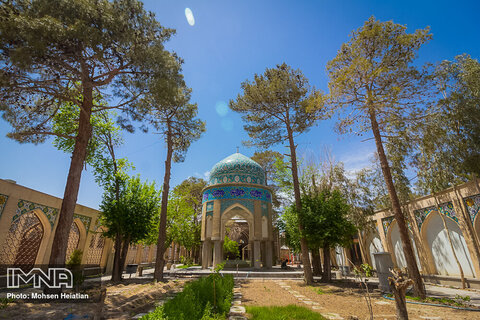Iran (IMNA) - In fact, travel marketers and tour operators contribute to such novel ideas in response to the soaring request of clients for new excitements and knowledge in the search of weird, bizarre, and unique memories.
It may seem peculiar to you but cemeteries as bridges between the present and the past, and the living and the dead, have been drawing their own fans both in groups or individuals each having specific interests.
Iran, a cradle of civilization, which is well soaked in history and culture, never disappoints cultural travelers with almost every taste even ones interested in cemetery tourism.
For intense, consider Shahr-e Yeri, known as the “city of the mouthless”! It is a unique archaeological site and cemetery in northwest Iran, embracing an Iron-Age fortress, three prehistorical temples, and tens of carved stones on which mouthless faces are depicted, all stretched across 400 hectares of several small hills.
The country is also home to a great number of brick tomb towers. Top on the list may be ones dedicated to the Prophet Habakkuk in Hamedan province. Kharaqan twin tomb towers in Qazvin province and the UNESCO-registered Gonbad-e Qabus in Golestan province are amongst others to name a few.
Needless to say that the UNESCO tagged Persepolis and its neighbor necropolis Naqsh-e Rostam are must-see destinations in southern Iran when it comes to cemetery tourism. Both bear absolutely majestic rock-hewn tombs where Persian Achaemenid kings are laid to rest. There are gorgeous bas-relief carvings above the tomb chambers with the kings standing on thrones supported by figures representing the subject nations below.
Over the past couple of decades, countless archaeological surveys have been yield ancient tombs, cemeteries many of which bear fresh evidence of ancient burial rituals and entombed objects dedicated to the afterlife.
In a most recent finding, which conducted just a week ago, the remains of 13 ancient skeletons, 11 of which human remains, were discovered at olden water ducts of Persepolis, shedding new light on the way of life in the ceremonial capital of Achaemenid Empire.
In another amazing discovery, made in 1993, miners in the Douzlakh Salt Mine of Zanjan Province, accidentally came across a mummified head that was very well preserved to the extent that his pierced ear was still holding the gold earring. The hair, beard, and the mustaches were reddish, and his impressive leather boot still contained parts of his leg and foot. In the flowing years, another “salt man” was also discovered one after another at the ancient salt mine. Based on academic studies, their textiles belong to the Achaemenid era (550-330 BC) and the Sassanid period (224 CE–651).
Over the past two months, the discovery of the skeletons of two Parthian ladies at the ancient Tepe Ashraf in Isfahan has been cemented a hypothesis that another ancient cemetery is being found within the city, offering valuable clues to uncover the obscure history of pre-Islamic Isfahan.
In cemetery tourism, contrary to popular belief, it is you yourself who will be the protagonist of a hot dialogue of past and present during visits to centuries-old tombs or cemeteries instead of listening to a curator of an exhibition!
Tehrantimes


Your Comment